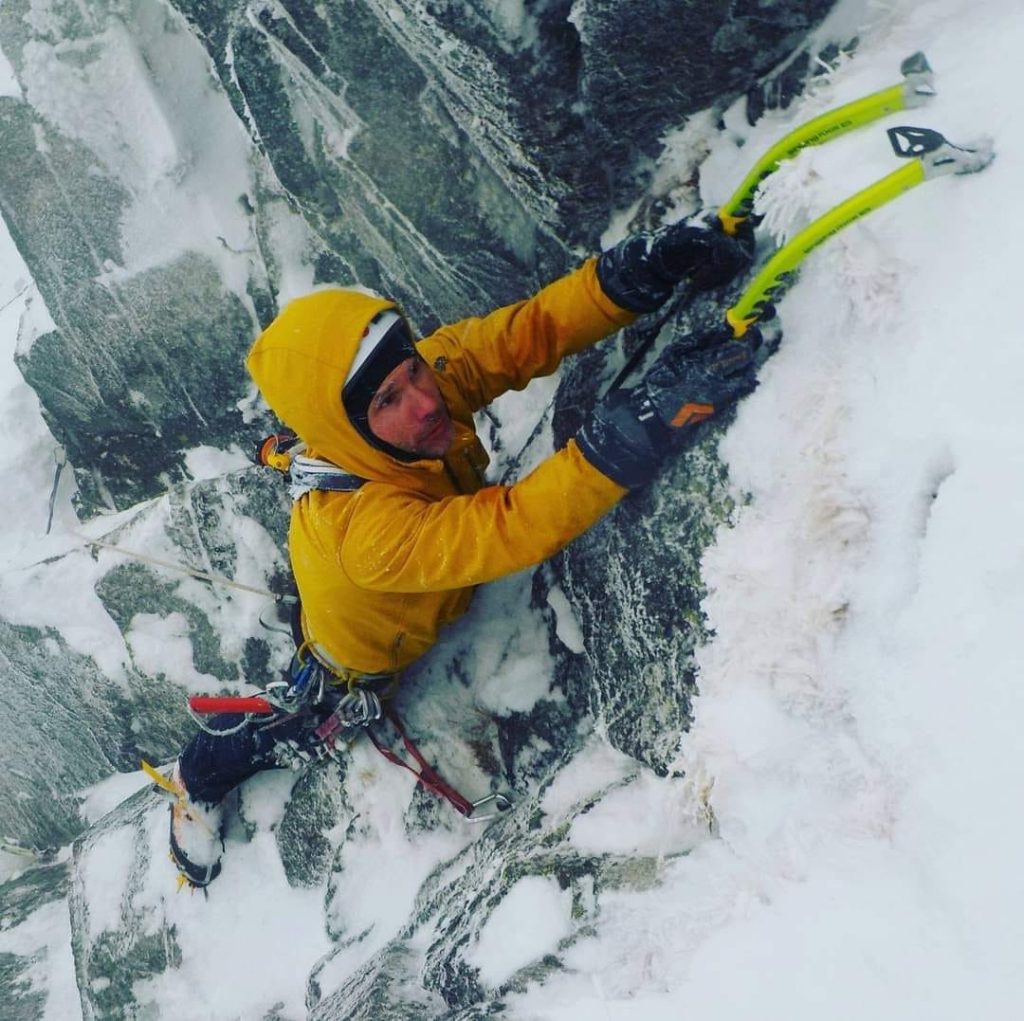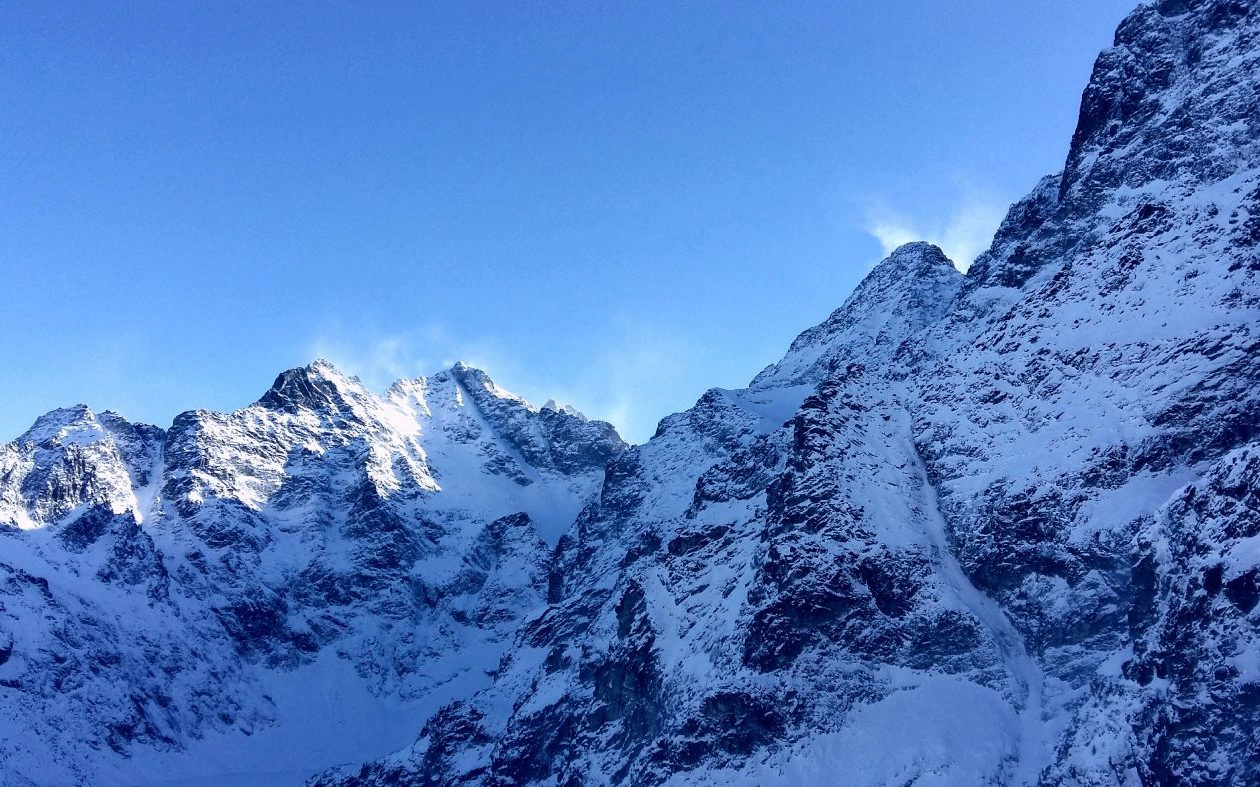In this post, I will have a brief look at what to wear in winter when trekking, mountaineering or climbing
Right winter gear is key to a successful trip. I use the term gear as opposed to clothes. I consider my clothes to be just another tool in mountaineering and climbing, as important as an ice axe, rope or rucksack. They need to do what I want them to do and create together my chain of safety! Not only look cool. So what to wear? This could become a real headache. We need to look at two problems, we could find ourselves freezing or sweating. In both cases, we end up losing a lot of energy to keep heat or dry wet layers. First, we need to consider a few factors such as weather, type of the actives, distance and time spent outside. I will dress differently for waking and differently for climbing that’s for sure! Generally speaking, the well-proven system is called “layering”. Sometimes climbers will say “dress like the onion”. A trick here is to be able to take off or put up layers according to our comfort and warmth. We can break down our “onion” layering system into inside layers (base layers), mid-layer (soft shell), outer layer (hard shell) and boots.
Underwear – the base layer
This winter gear aims to maintain a dry layer of air next to the skin and wick moisture away from the body, ability to transfer sweat out of the body is extremely important and affects all other layers. The base layer must be breathable, maintaining temperature and comfort. Merino wool could be itchy so the combination of merino and polyester might be a great option. If you go only for a day a typical polyester would be an affordable choice. It’s warmer than Merino but it goes without saying that it will smell after a day of use. Long sleeve, neck zip is an individual preference. I have recently switched to the short sleeve as I’m getting too warm. Absolutely no cotton! as it will stay wet and cold and so do you!! If you want to spend money then buy the best socks you can. Warm, long, without stitching, merino wool. Having dry, spare in your backpack could be a game-changing tactic!
Second layers – mid-layers
This layer aims to provide warmth by trapping air close to the body. Our layer should be breathable and easy to dry out. Most synthetic materials like fleece are good at shedding water and they are quick drying. Some people use a wind stopper but that option is significantly colder than the fleece but lighter. Now a very popular option is PrimaLoft. I use one which is a vest-type PrimaLoft with stretch synthetic sleeves. One of my favourite winter gear.
Softshell – mid-layer or outer layer
A soft shell aims to keep wind and monsieur out, keep us in comfort and maintain ventilation. It should enable freedom of movement. This winter gear should be made from high-performance stretch fabrics and have a high collar and hood. After years of opting out of having a soft shell, I have become a big fan of this layer. It does breathe better than a Gortex jacket and for winter it’s waterproof enough. PrimaLoft is another option.
Pants and overtrousers
When choosing pants you should follow the same principles as a soft-sell jacket. Pants with braces are great options as you will not have a cold spot on your back. I have seen so many naked lowerbacks on our winter course, especially during self-arrest training. Look out for high-performance stretch fabrics with reinforced knees and side ankles. A string that you can put over your boot sole to avoid your legs rolling up is a smart addition. They must be comfortable allow freedom of movement and should have ventilation zips. You should have waterproofs as well which usually are made out of Gortex (see below). Being able to open them by long zip completely, on the side is a great trick and will allow putting them on without taking crampons off. It’s a rare feature I wonder why?
Hard shell – outer layer jacket
Probably the most overrated and expensive winter gear. The hard shell aims to keep out wind and water (snow in our case) but allows moisture to escape (which most jackets don’t do). Our jacket should be robust and resistant to tear and wear and should be light in weight. A high front collar, easy-to-open zips, side zips for ventilation, high pockets, huge hood, Velcro cuffs, long arms, and anatomical shape this is all attributes of a good jacket. There are few systems now on the market with GORE-TEX and eVent being the most reliable ones. I wear soft sell instead and when is getting cold and it starts to snow I put PrimaLoft or a down jacket on top. When is raining I simply don’t climb 🙂 A few so-called wintery years in Wales and Scotland will do. Enough is enough 🙂
Down or synthetic down jacket
The down jacket should do what they are meant to do – keep you warm. Go for 800+ goose-down fill and a bigger size than you think so you can put this on top of your other clothes. The synthetic warm jacket is very good as well as it will perform even when wet. Hydrophobic down is an interesting option, apparently when wet it will keep you warm anyway.
Gloves
Gloves must be warm and dedicated to winter activities. Any “make-do” systems will definitely go wrong! I recommend having at least two pairs. Have spare thin gloves and mittens if you have cold hands. I personally would not pay for a GORE-TEX one. Your hands will sweat and you most likely will have to deal with snow all the time so they will go wet no matter what. Buy two, or three pairs of good gloves rather than one expensive. The hut should be warm but if you wearing a helmet and hood try to use a scarf or buff. This is working better for me. I like balaclava which protects the face and neck.
Gaiters
The aim is to stop the snow and moisture from entering the boots. They provide extra insulation and should be full-length, waterproof, and breathable. I would go for full-length Velcro rather than zip and please don’t wear them when you don’t need them – it looks so bizarre!
Mountain Boots “fit or not to fit” – winter gear dilemma
Boots are the most important item of winter gear and equipment. They are essential for safety and comfort. In my opinion, there is no compromise here. You may get away with other stuff but if your mountain boots are incorrect then you are done! You may even lose your toe! Around Polish “Ice Warriors” in the 80thies there was a joke that if you have all toes you are a rookie, not a proper alpinist! 😉 I like my toes I think you do too.
They need to fit correctly (with thick socks) and support our feet. This is probably the most stressful equipment to buy. There are super expensive and hard to tell if they fit or not. I use the same brand which helps me choose the size. Another test I do is to take out the inner sole and stand on it. With a thick sock, you should have around 1cm of free space in front of your toes. Generally having them bigger is better than having them too small! It goes without saying that they have to be waterproof, warm, light and compatible with crampons. And for the right activity, you intend to do! Having to flex boots when you climb is a nightmare and vice versa when walking, too stiff boots will kill your legs.

Short summary
So for trekking, my layers could be:
- the merino base layer short sleeve,
- fleece,
- soft shell,
- short bottom base layer,
- socks,
- thin pants,
- gaiters,
- B1 boots,
- hut,
- and thin gloves.
For mountaineering:
- the merino base layer short sleeve,
- thin fleece,
- PrimaLoft,
- longer bottom base layer,
- medium-thick socks,
- soft shell pants,
- B2 boots,
- buff
- and gloves.
For climbing:
- the merino base layer short sleeve,
- PrimaLoft,
- soft shell,
- down jacket (when belying),
- longer bottom base layer,
- soft shell pants and waterproofs if needed,
- B3 boots,
- 3 pairs of gloves and mittens,
- balaclava.
I will carry in my backpack some spare clothes (gear) and add-ons according to the given conditions.
I hope that this short article will help you a bit to make some smart decisions about winter gear in today’s saturated market!
Once my alpine instructor said:
“Don’t become gearoholic! The gear doesn’t climb! If you spend so much money on clothes and equipment you won’t have any money to go into the mountains! “
- Alpine Skills – How to rope up on the glacier?Navigating glaciers demands precision. Learn the art of roping up for crevasse safety in our winter mountaineering course. Discover optimal team sizes, knot essentials, and equipment recommendations. Elevate your alpine skills with us and conquer glaciers confidently. Safety and mastery await – join us today!
- An ideal development path in mountaineering or climbingUnlocking the Alpine Path – a Safe Journey into Mountaineering. Embarking on a mountain journey requires not just courage, but knowledge. Accidents in these majestic landscapes can be averted with the right education. Learn from Piotr Sztaba, a seasoned Polish Tatra Mountain Instructor, as he lays out the ideal progression for aspiring mountaineers. Discover the critical phases of skill-building, from conquering rock walls to winter peaks. Choose a path of competence, wisdom, and thrilling adventure.
- Climbing in Poland – the short history and main regionsA Glimpse into Poland’s Climbing Legacy – embark on a journey through Poland’s climbing history, marked by the daring spirit of pioneers like Antoni Malczewski and legendary figures like Kukuczka and Rutkiewicz. From conquering Aiguille du Midi in 1818 to mastering Himalayan winter ascents, Polish climbers have etched their legacy. Explore the diverse climbing regions – from the majesty of the Tatra Mountains to the limestone crags of Jura Highlands and the granite challenges of Sudety Mountains.
- Climbing rack for winter climbing.Winter climbing is the most extreme type of climbing which requires years of experience and practice. Not only placing a gear is difficult but the assessment of the quality of…
- What to wear in winter?Winter Gear Guide – Dress-code in the Tatra Mountains. Facing the winter wilderness demands strategic clothing choices. Beyond style, each layer is a tool that contributes to safety and comfort. Discover the secrets of effective layering, from base to outerwear, and make the right call between staying warm and avoiding sweat. Navigate the winter wonderland confidently with the perfect gear setup.
- Winter in the polish Tatra Mountains: trek – climb – ski – party or other way around!Explore the enchanting Tatra Mountains during winter – a unique blend of tatras beauty and adventure. Nestled between Poland and Slovakia, these peaks offer diverse activities like mountaineering, skiing, and climbing. Discover the allure of Morskie Oko Lake and Hala Gąsienicowa, perfect for winter mountaineering and ski touring. Trek, climb, or ski through the stunning landscape!
